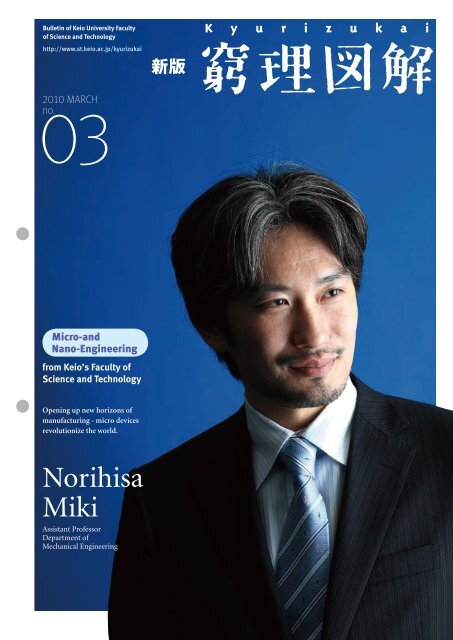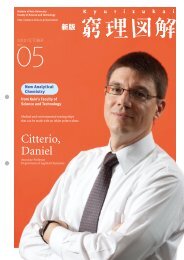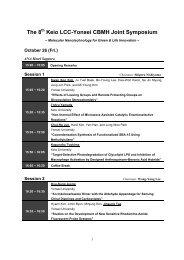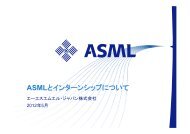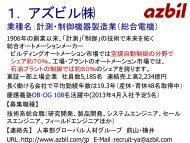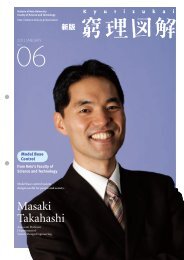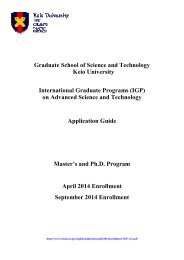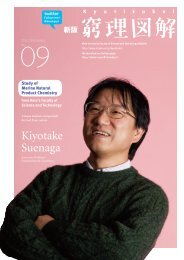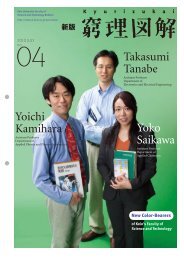Norihisa Miki - Keio University
Norihisa Miki - Keio University
Norihisa Miki - Keio University
Create successful ePaper yourself
Turn your PDF publications into a flip-book with our unique Google optimized e-Paper software.
As a small boy, was it your dream to<br />
become a research scientist?<br />
No (laughter). I was born in the city of<br />
Tatsuno, Hyogo Prefecture. My family<br />
is a long-standing soy sauce maker -<br />
an environment having nothing to do<br />
with academic research. Fortunately my<br />
standing at school was so good that as an<br />
elementary school boy I also attended a<br />
college-oriented cram school famous for<br />
Spartan education. Then I advanced to a<br />
college-oriented school with consistent<br />
junior and senior high school education,<br />
and advanced to the <strong>University</strong> of Tokyo's<br />
Faculty of Engineering. It was like a<br />
natural course of events (laughter). As I<br />
recall those young days, I think I could<br />
devote myself to studying because I had a<br />
number of friends with whom to compete<br />
and enjoy learning, rather than because I<br />
liked studying.<br />
You mean you didn't have hard time<br />
studying?<br />
Not then but now I'm having hard time<br />
4<br />
Interview<br />
Listening to what Assistant Professor Akiko Takeda says<br />
Leading MEMS studies with the spirit,<br />
“Conceive like an amateur<br />
and do the job professionally.”<br />
“I hate the word ‘setback’,” says Dr. <strong>Norihisa</strong> <strong>Miki</strong>. In Japanese, “setback”<br />
is written in two characters: “being disheartened” and “breakdown.” He<br />
maintains a belief that you'll be okay if you are not broken mentally when<br />
you experience a setback. With his inquisitive character coupled with a<br />
challenger's spirit and inborn brightness, Dr. <strong>Miki</strong> is pushing forward through<br />
his career as a research scientist. Under a motto of “Enjoy what you're doing,”<br />
he strives to open up new horizons for MEMS, demonstrating his unrestricted<br />
power of conception and taking advantage of substantial achievements he has<br />
accumulated.<br />
(laughter). I may be a type of person<br />
who can handle almost anything rather<br />
smartly but doesn't have any particular<br />
field at which he is incomparably strong.<br />
As such, I chose my course without a<br />
definite intention or desire. During the<br />
first and second years at the university, I<br />
was interested in biology and elementary<br />
particle physics. But it was about the time<br />
for me to advance to an undergraduate<br />
course that a new field of study known as<br />
“virtual reality” came into the spotlight.<br />
Intrigued, I chose to advance to the<br />
Department of Mechano-Informatics.<br />
Later I became interested in robotics.<br />
When choosing a seminar as a senior,<br />
I was admitted to the laboratory of<br />
Professors Hirofumi Miura and Isao<br />
Shimoyama, the authorities of robotics.<br />
In those days, the “ASIMO” robot was<br />
yet to be announced by Honda Motors,<br />
and research into biped walking robots<br />
and artificial intelligence was almost at a<br />
deadlock. Amid such circumstances, in<br />
an attempt to find a breakthrough, the<br />
laboratory just began studies on micro<br />
robotics. Assuming that if a human being<br />
is the model for a biped robot, then an<br />
insect should be the model for a micro<br />
robot, I began studying to create an<br />
insect-type robot based on MEMS.<br />
What makes studies on small objects<br />
is that a force that can work on an object<br />
varies according to the size of the object.<br />
For example, if an object's size becomes<br />
one-tenth its original size, its surface<br />
area becomes one-hundredth whereas its<br />
cubic volume becomes one-thousandth,<br />
meaning a drastically reduced force of<br />
gravity placed on the object. This is why<br />
a flea can jump to a height some 50 times<br />
its own height. This in turn means that<br />
a robot appropriate for its intended size<br />
can be designed by taking such a factor<br />
into account. For example, we can even<br />
say that the major difference between the<br />
wing of aircraft and that of insects mainly<br />
comes from the difference in scale. By<br />
the way, the topic of my graduation thesis<br />
was on a robot controlled by an insect.<br />
In this system, the robot moves following<br />
the movement of the insect as it walks on<br />
a ball.<br />
You made effective use of your<br />
biological knowledge, didn't you?<br />
In this way I had fared as my personal<br />
interest went. But it was about that time<br />
that I began to think about my future<br />
more seriously. My options included<br />
succeeding my father in the family<br />
business and finding employment with<br />
a manufacturing company. As a Master<br />
Student, I had an opportunity to attend<br />
an overseas academic society meeting,<br />
accompanying my professors. I saw them<br />
shaking hands with foreign scientists<br />
and talking with them frankly. It was so<br />
“cool and impressive” that I made up my<br />
mind to advance to the doctor's course<br />
(laughter). In fact, I found my life during<br />
the doctor's course very fulfilling.<br />
In those days, there were many<br />
opportunities for me to participate in<br />
exchange meetings involving different<br />
industries. Having talked with people<br />
from various industries and different<br />
occupations, I came to think that a life<br />
different from many others might be<br />
good although my way of life until then<br />
had been: “Don't go against the flow.”<br />
This thought urged me to advance to<br />
the doctor's course while most of my<br />
fellow students found employment in the<br />
business world. But I have no regret with<br />
my decision. Devoted to research from<br />
morning till dawn the next day when<br />
crows begin to caw (a little after 3:00 a.m.)<br />
- this had been my daily life at the lab<br />
back then.<br />
At that time I was immersed in a project<br />
to create a tiny (less than 1cm in length)<br />
helicopter that can fly when a magnetic<br />
field is applied from the outside. When<br />
it comes to “flying,” letting wings rotate<br />
is much more efficient than letting them


